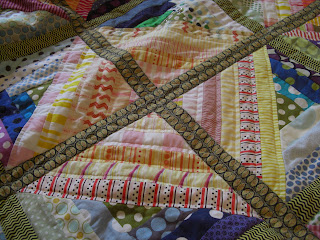No. Not curved piecing! Mastering-a-new-technique learning curves.
My latest quilt is called "Morse Code". You may have noticed I like to play with words as well as fabric. I was trying hard to think of a name connecting the spots and the stripes and then I realised they were really dots and dashes.
You can see a bit of quilting happening. I am NOT a machine quilter, but since joining blogland I have seen ordinary mortals managing this amazing feat. After dipping my feet in a couple of times with two recent baby quilts, I thought all the straight seams in "Morse Code" lend themselves to walking foot quilting. A larger quilt presents a greater degree of difficulty than baby quilts, particularly in fitting its bulkiness under the arm of the machine.
I am only up to straight lines, but as the saying goes, "baby steps first". Having watched from a distance I know a few things, such as get the chair up high, stop for regular breaks (this post comes to you courtesy of a break), have a large area to rest the bulk of the quilt on etc.
So I took over the dining room.
It has been a real journey of discovery. Now I understand a little more of things other quilters discuss. For instance, this is a cotton batting with a scrim. Boy does it pill. I have hardly quilted much on it and already there is evidence of pilling.
I am using the same cotton thread that I use for applique and for machine sewing, but I don't think it's the best one for machine quilting. It seems to shred on removal. Yes, there has been some removal, but not as much as I expected, so I still have a smile on my face.
My husband, who could be described as quilt non-sympathetic, got involved and helped me to design a pattern that doesn't require much of the dreaded starting and stopping.
I would appreciate comments and tips from any experienced machine quilters. To my long arm quilters, Adri, Kate and Verna I don't think you'll be losing too much business from me. Altogether it has been a positive experience, but now my break is over and I have some serious work to do!


5 comments:
your doing great !! Keep going !!!
Practice, practice, practice. That's the principle behind machine quilting. Plus push your table against a wall so your quilt can't go down behind your machine. Make sure you are using a Quilting needle and proper threads, this will make things easier. Buy a dvd or two on machine quilting for domestic machines, there are a lot of great "workshop in a box" tutorials out there.
I'm with you on straight lines only and even that is difficult on a large quilt. My problem is I just don't want to spend the practice time required to get better. I am currently trying straight lines to anchor the blocks, then adding some hand quilting (won't do that with Warm and Natural again.) One thing I want to try that I've seen in photos is those big clamps which hang from the ceiling to hold some of the weight of a big quilt.
quiltfever.wordpress.com
Love the quilt! oh machine quilting is harder than most people think!
it just takes practice and make sure you stop and take breaks!
rest those shoulders and remember to breathe!!!!
you can do it!
Kathie
We all have to start at the begining and I think you've done really great. It is such a lovely quilt. Interesting what you say about the batting, I would have thought a scrim would prevent pilling.
I heard a good tip from a machine quilteer for when you're using the walking foot. Instead of backstitching at the begining and end, set your machine on a tiny tiny zigag (I think you have a 440) and you just press the number button at the start and stop, then go back to the straight stitch.
Post a Comment